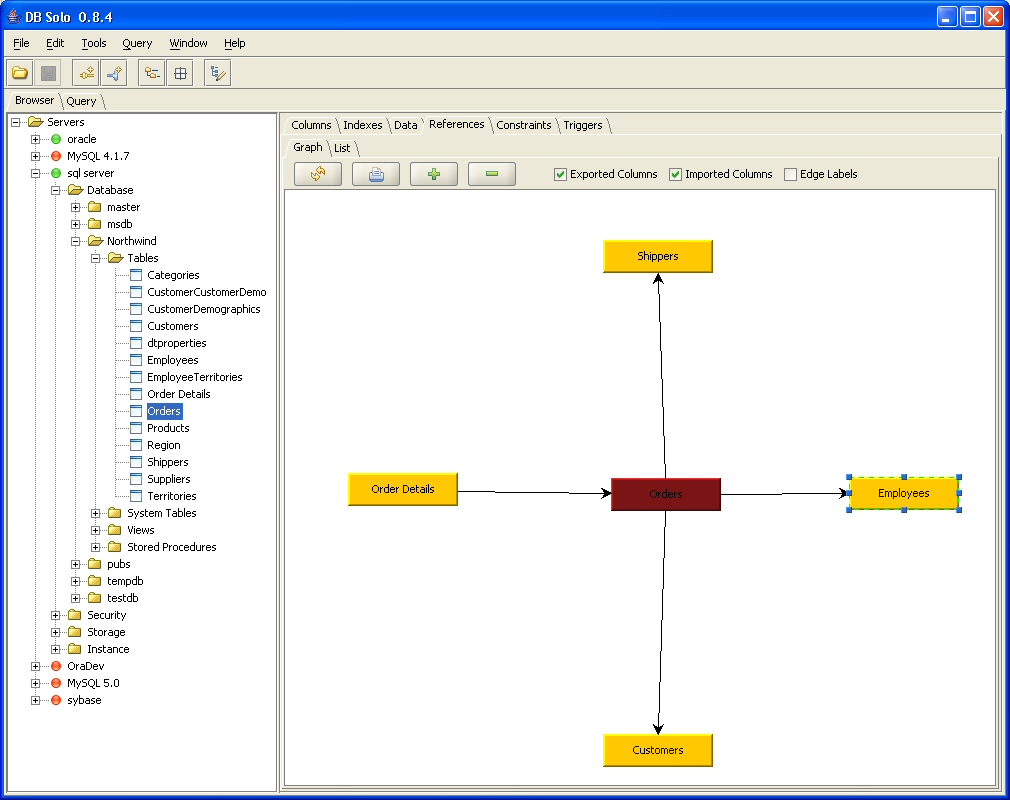
List of data compare, synchronization and migration tools. Data comparison is a process to inspect the structural differences between the source database and the target one. To carry out the comparison process, databases must meet the conditions of compatibility. However, some comparison tools have the ability to synchronize resources whose original schemas did not match each other.
Db Solo
DB Solo supports most major relational database products available today including Oracle, Microsoft SQL Server, Sybase, DB2, Solid, PostgreSQL, H2 and MySQL. You can manage all of these DBMS products -- even at the same time -- from a single application.
DB Solo runs on multiple operating system platforms, so you don't have to buy another tool only because you want to run manage your databases from different operating systems. Since DB Solo is written in Java, it provides the same user experience on all supported operating system platforms.
DB Solo also supports Japanese, Korean and Chinese character sets in all of its windows, allowing you to view and edit Asian character set-based data in your database. All you have to do is change the display font of DB Solo to one that can display the characters need to use.
You would be hard-pressed to find a tool with DB Solo's capabilities anywhere near the price range of DB Solo. Please compare our prices and features with competing products, by choosing DB Solo you simply can't go wrong.
DB Solo supports the following operating systems.- Mac OS X
- Microsoft Windows NT, 2000, XP, Vista, 7, 8 and 10
- RedHat & Ubuntu Linux
- Newspaper press (97 dB). 90: 4 times as loud as 70 dB. Likely damage 8 hr exp: Garbage disposal, dishwasher, average factory, freight train (at 15 meters). Car wash at 20 ft (89 dB); propeller plane flyover at 1000 ft (88 dB); diesel truck 40 mph at 50 ft (84 dB); diesel train at 45 mph at 100 ft (83 dB).
- Showing 1-20 of 507 topics. Problems installing DbSolo5 with latest JAVA in Linux - Workaround: Christos Pontikis.
- Oracle 8.1.7 and later
- SQL Server 2000 and later
- Cassandra 2.0 and later
- Sybase ASE 12.5 and later
- Vertica 6.0 and later
- Sybase SQL Anywhere 9 and later
- MySQL 3.23 and later
- DB2 LUW 8.x and later
- Solid EmbeddedEngine™ and Solid BoostEngine™
- HSQLDB 2.0 and later
- SQLite 3.x
- PostgreSQL 7.3 and later
- H2
- Multiple simultaneous database connections
- View/Create/Drop databases, schemas, tables, views, stored procedures, users, roles, sessions, tablespaces, data files, synonyms, sequences, rules, defaults and user defined data types using the advanced DBA Features.
- View/Edit /Create/Delete/Print table data
- Export table/view data as CSV or HTML
- Create/Drop tables and indexes
- View table constraints, indexes, columns and triggers
- View table references in a graph or list format
- Retrieve all or filtered rows of a table from database and search, sort and export the result set
- View images stored in BLOB columns (GIF, JPG and PNG)
- View ASN.1 data in a tree format
- View XML data in a tree format

- Execute one or more SQL queries
- Auto completion
- Syntax coloring
- Persisted query history
- Multiple result sets
- Stored procedure creation
- Configurable statement separators
- Support for server-side comments (hints)
- Sort, search and print the query results
- Export result sets as CSV or HTML
- View images stored in BLOB columns (GIF, JPG and PNG)
- View ASN.1 data in a tree format
- View XML data in a tree format
Table creator allows you to create new tables by providing an intuitive wizard-based interface. The table creator allows you to define columns and constraints for your table without knowing the exact SQL syntax needed for table creation. It also provides a preview screen where you can see the exact SQL statement that will be executed. If you wish, you can copy the SQL from the preview screen to the Query Tool and modify or save it before sending it to the database server.
Index creator lets you create indexes for your tables with a couple of mouse-clicks just like the table creator lets you create tables. Supports several DMBS vendor-specific features such as bitmap indexes for Oracle and Fill Factor for MS SQL Server. You can view/save the generated SQL in the preview window.
The database object browser not only allows you to view table data without knowing SQL, you can also edit the data in-place by double-clicking on a cell and typing in the new value. You can also create new rows in your table or delete existing rows without typing in any SQL statements. You can insert values into BLOB/CLOB columns either manually or store the contents of a file system file.You can add your favorite queries, tables, views and other database objects to your Favorites list, just like you would in your Web Browser. By selecting an item from the Favorites-menu you can immediately bring up frequently used database objects in the browser tree or queries in the query panel. This time-saving feature also allows you to organize your favorites using folders in a tree-like hierarchy.
Favorites toolbar allows you to access your favorite database objects and queries even faster. Favorite toolbar is placed under the main toolbar, enabling you to access its contents with a single mouse-click.
DB Solo allows you to export data from a table or the result set of an ad-hoc query to an external file or system clipboard. The export process is highly customizable allowing you to select rows, columns, column ordering and formats for the output among other things. The preview functionality allows you view the first rows of your customized output before exporting large sets of data.Solo Db Plan
The supported export formats are CSV and HTML.
